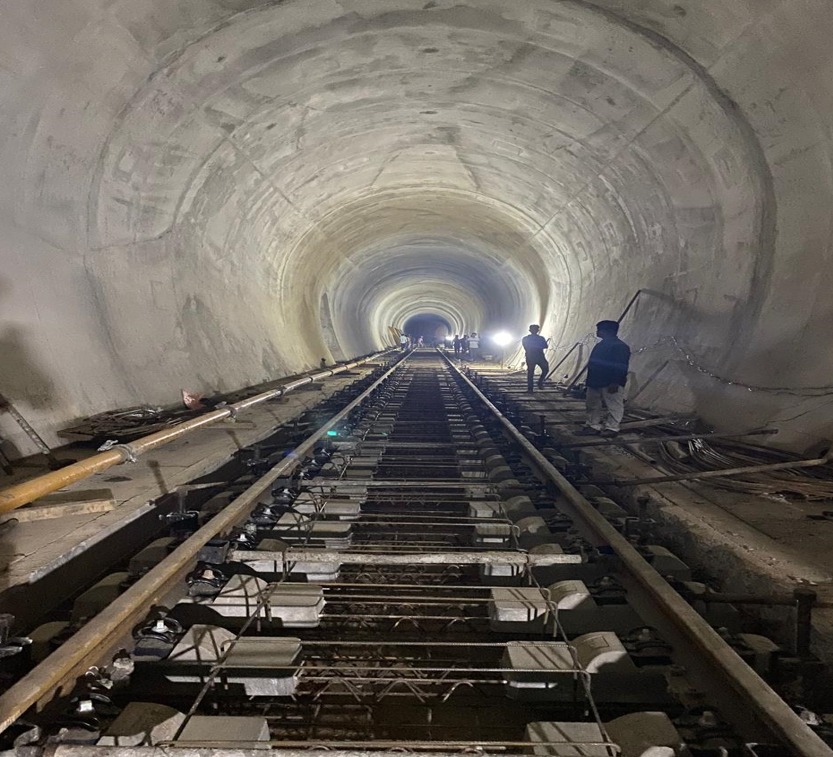Bhubaneswar: East Coast Railway has been adopting advanced ballastless track technology in Railway Tunnels while constructing new projects in its jurisdiction. This strategic move is set to revolutionize the safety, efficiency and sustainability of rail transport, particularly in challenging tunnel environments.
ECoR initially started Ballastless track in Tunnel with Rheda 2000 Block System for Tunnel No.1 for 600 meters tunnel between Baiguda & Kakirigumma Stations in connection with Koraput-Singapur Road Doubling Project of East Coast Railway.
This ballast less track system will also be implemented at all the under construction tunnels of various ongoing projects over ECoR. Plans have also been taken to replace existing tracks in tunnels with ballast less ballast less tracks. Tunnels works are going on in Kottavalasa-Kirandul, Koraput-Rayagada Doubling projects and in new line projects like Khurda Road-Balangir and Talcher-Bimalagarh Rail Line projects.
Ballastless train tracks, particularly in tunnels, offer several significant advantages that are ideal for various key merits. These are enhanced durability and longevity; increase stability & safety; reduce maintenance cost; improved ride comfort and noise reduction; efficient space utilization, environment friendly; improved drainage & water management and quicker installation & commissioning.
Enhanced Durability and Longevity
• Reduced Wear and Tear: Ballastless tracks are more robust and require less maintenance compared to traditional ballasted tracks. The absence of ballast eliminates issues like ballast degradation and shifting, which can cause track misalignment.
• Longer Lifespan: The materials used in ballastless tracks, such as concrete and steel, provide a longer service life, making them a more sustainable option for tunnels.
Increased Stability and Safety
• Better Track Stability: Without ballast, the track structure is more rigid, ensuring consistent alignment and reducing the risk of derailment. This stability is especially crucial in tunnel environments where space is confined.
• Higher Load Capacity: Ballastless tracks can handle higher loads, making them suitable for high-speed rail or heavy freight traffic that may pass through tunnels.

Reduced Maintenance Costs
• Minimal Maintenance Requirements: The robust design and construction of ballastless tracks mean that they require less frequent maintenance. This is particularly beneficial in tunnels, where access for maintenance work is often more challenging and costly.
• Lower Operational Disruptions: With reduced maintenance needs, there are fewer operational disruptions, leading to increased efficiency and reliability of train services.
Improved Ride Comfort and Noise Reduction
• Smoother Ride: The rigid construction of ballastless tracks ensures a smoother ride for passengers, with reduced vibrations and noise. This is a significant advantage in tunnels, where noise levels can otherwise be amplified.
• Noise Damping: Ballastless tracks can incorporate noise-damping materials, which further reduce noise pollution, improving the environment for both passengers and workers in the tunnel.
Efficient Space Utilization
• Compact Design: The compact design of ballastless tracks allows for more efficient use of space in tunnels. This is particularly advantageous in urban areas where space is at a premium.
• Flexibility in Tunnel Design: The absence of ballast gives engineers more flexibility in designing tunnel profiles, potentially reducing construction costs and allowing for more innovative tunnel designs.
Environmentally Friendly
• Reduced Environmental Impact: The long service life and reduced need for maintenance translate into a lower environmental footprint over the track’s lifecycle. Moreover, the absence of ballast, which often involves quarrying, is another environmental benefit.
• Less Dust and Debris: Ballastless tracks generate less dust and debris, which is especially important in the enclosed environment of a tunnel, improving air quality and reducing the need for cleaning.
Quicker Installation and Commissioning
• Faster Construction: The prefabricated nature of many ballastless track systems allows for quicker installation, which can speed up the overall construction timeline of tunnels.
• Immediate Operational Readiness: Once installed, ballastless tracks can often be used immediately, without the need for the track settling period that is typically required for ballasted tracks.
Improved Drainage and Water Management
• Effective Water Drainage: Ballastless tracks are designed with integrated drainage systems that efficiently manage water accumulation, which is particularly crucial in tunnels. This helps to prevent water-related issues such as track deformation, corrosion, or flooding, thereby enhancing the overall durability and safety of the track.
• Reduced Risk of Water-Related Damage: The superior drainage capability minimizes the risk of water pooling, which can lead to deterioration of the track structure or affect train operations. This is especially beneficial in tunnels where water management can be more challenging.
These merits make ballastless tracks a highly advantageous option for modern tunnel construction, offering long-term benefits in terms of cost, safety, and environmental impact. This merit further enhances the appeal of ballastless tracks, particularly in tunnel environments where managing water effectively is critical for maintaining track integrity and safety.




Comments are closed.